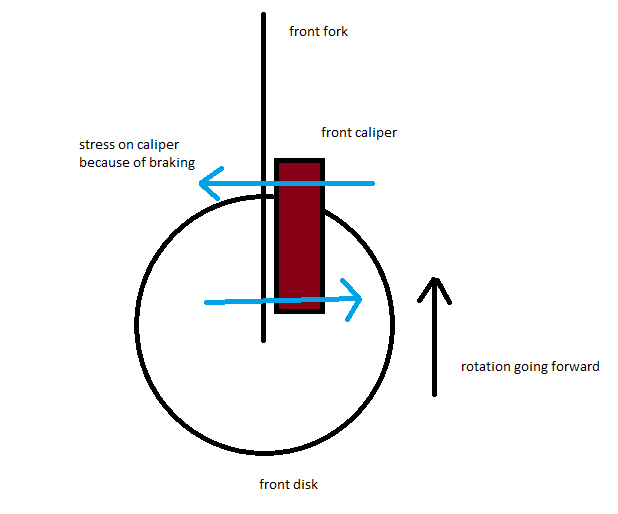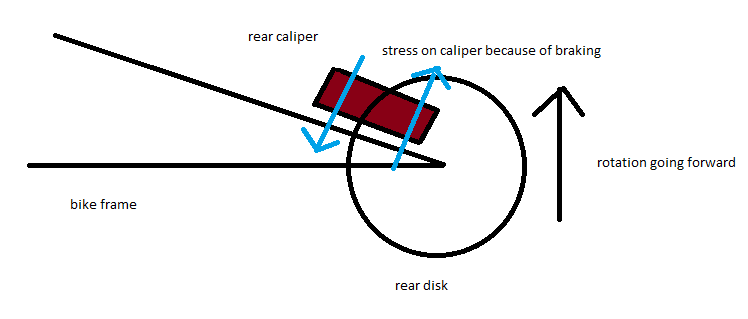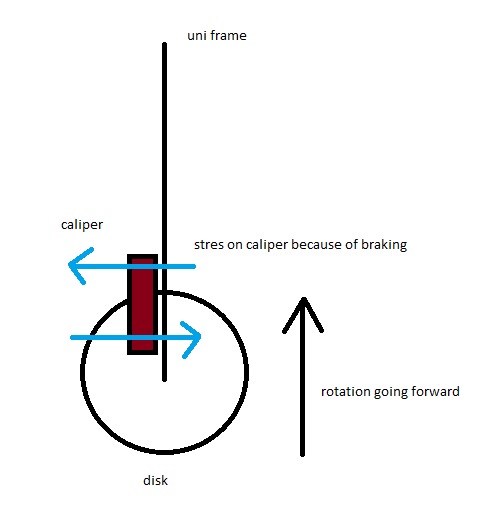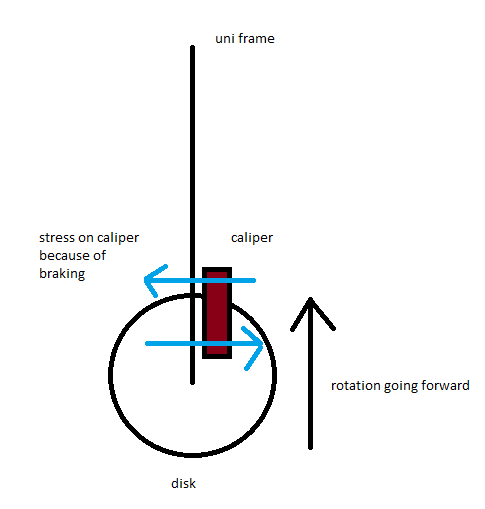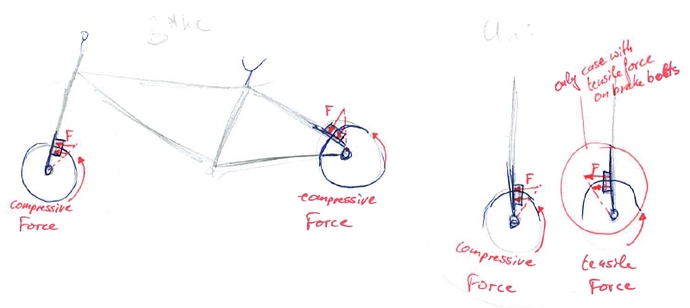I haven’t tried an aluminum frame with a disc tab but I’d like to and I think it would work OK. QU-AX has a frame like that but I haven’t seen it for sale by itself. The only other alternative is to get a disc tab welded on and it’s maybe a little harder to find someone who has experience with that vs. a steel frame.
Municycle.com shop (Germany) has some for sale and you also have the latest KH frames that are aluminum and with a disk tab.
KH frames are made for external rotor (tab on the right) and QX frames for internal rotor (tab on the left). I guess, external rotor would make no sense for a freewheel 
Silly question but: what if you run the frame with the tab on the left ? Unicycle frames are not really directional except if you have an OCD to have the brakes on the back and a disk caliper doesn’t care either which way it goes as long as it is properly covering the disk…
Too bad I don’t know somebody with a QX wheelset just for the sake of such experiment ! ![]()
![]()
I allways asked this question to myself.
Then the brake force will pull the caliper away from the frame instead of pushing it against. So just the difference between tensile and compressive force. Maybe the two bolts are strong enough to withstand the tensile force over long term … maybe not.
Since I have never seen a caliper mounted this way, I decided not to test it and use a d’Brake with support strut on a QX frame without disc tab instead of an inverse QX frame with disc tab.
Old video, but I’m still loving the clip where you ride one footed ![]()
![]()
That is a good point. However, on the back of a bike the caliper is mounted on the opposite direction of the front caliper. As the back calipers are mounted on adapters, I would guess that it makes for a good stress test of the caliper/adapter combo.
However, the back of a bike is 30% of the braking force compared to 100% on a unicycle even though the speed and total weight is less… Now we need also somebody good in maths ! ![]()
I don’t understand this point. On the front, as well as on the back, the braking force pushes the caliper against the fork/frame.
Sidd, are you confusing v-brakes with disc brakes? V-brakes are on opposite sides (front brake in tension away from fork, rear brake in compression toward frame) but both front and rear disc brakes are on the same side.
I was focusing on the position of the caliper compared to the disk (caliper behind the disk on the front and caliper on top/slightly in front for the rear) and I totally forgot to consider the forces induced by the action of applying the brake.
I did 4 sketches on Paint just to summarize it and compare and it doesn’t look very differently from the existing 3 cases…
Now, it will be easier for me to see what I missed ![]()
You painted every caliper with one bolt under tensile force and one under compressive force. That isn’t right. The center of momentum for the Braking force is the center of the disc/wheel, not the center of the caliper.
Thanks for the links! I don’t think Qu-Ax was selling the frame alone when those unicycles first came out and I’ve only been checking at Goudurix lately since it’s easier and cheaper to ship to the US from Canada vs. Europe. I need to figure out what the clearance of that frame is compared to a Nimbus and if it fits my setup (3" Felt Berm Master on a 65mm rim) I’ll give it a try.
Well, an external rotor would be capable of stopping your feet which is marginally useful but has no effect on the wheel turning, as you know.
Yes, unicycle frames are generally symmetrical front to back with the exception of the slot for the seat post so you just have to turn around the clamp. I’ve had disc tabs put on the wrong side and did just that. I have a fixed 24" KH with the disc tab and I’ve wondered about riding with the caliper in front. I’m no engineer but that just doesn’t seem like a good idea. I’ve survived one braking accident unscathed (D’Brake snapped and mangled my rotor) and I don’t want to push my luck. Calipers are finicky enough running in the right direction.
Thanks! I’ve been focusing on improving my technical muni riding on fixed unicycles for the past year and when I ride my freewheels it’s been either my geared one or my peg unicycle. Now that the setting Winter sun has taken away my main technical trail I’m planning to ride my other freewheels more. Besides jumping I haven’t practiced tricks very much. I’d like to work on it more but I don’t have a great place to practice. I’d at least like to get proficient at pedaling backwards and get better at switch stance (left foot forward vs. my normal right foot forward). Have you seen Flaviu’s video:
Thanks Eric for the clarification ! I knew I was missing something but it is always clearer with a picture 
I don’t know how much stress the caliper has to deal with compared to a set of Magura but I remember seeing a couple of riders with the magura brakes on the front.
(back on topic  )
)
It’s great to have choices in production frames and to know that any steel frame can be modified at a reasonable price.
@waaalrus: What made you go for the steel tab ? Was it because of your D’Brake failure ? Or was there vibration/noise/something-else that did not feel right on an aluminum frame ?
It started in this thread. Back then I thought the problem might be the aluminum frame, possibly due to the difference in the modulus of elasticity between steel and aluminum. Now I’m thinking it was the combination of the aluminum frame with the aluminum D’Brake. Trying an aluminum frame with an aluminum disc tab might help to answer this question. I can’t speak to the engineering aspects of it but here’s the raw data:
- When I ride an aluminum frame (Nimbus Oracle) with a D'Brake (aluminum) I do not get sufficient braking. I can slow down OK but cannot come to a complete stop as quickly as I would like.
- A steel frame with a D'Brake (aluminum) gives me sufficient braking but I believe this combination caused the D'Brake to snap over time with the amount and force of braking that I do.
- A steel frame with a steel disc tab gives me the best braking experience I've had so far.
Why only marginally? I was thinking of trying that.
Since the disk is attached to the cranks (which on a freewheel, spin independent of the hub), when you apply the brake, the cranks won’t turn, but the hub will keep freewheeling. Accomplishing nothing.
I know how it works, I just thought locking the cranks might be more useful.
Over time locking my legs in a split position has become very natural although it requires effort. Locking the cranks could theoretically save some of this effort and would provide a more stable base in general but I’m not sure how useful that would be. I tend to think it would be more useful when I’m sitting in the saddle and have better leverage. In that case it would be more like regular coasting on a fixed unicycle. However, I usually am up off the saddle when I’m coasting for a long time on a freewheel unicycle. From a practical point of view it would be difficult for me to work two sets of brake handles and even if it was just the one that locks the cranks it’s a little harder to balance with one hand ready at the brake (although I do that now). More importantly, I don’t know if my muscle memory could adjust to the new pattern. The equipment is harder to come by, too (I have a set of Sinz cranks and a rotor that fits them but they’re ISIS and I would need cotterless). It’s an interesting idea, though!
Would a friction shifter work?
It might work over long, predictable terrain but more direct control is probably needed for any kind of variation.
